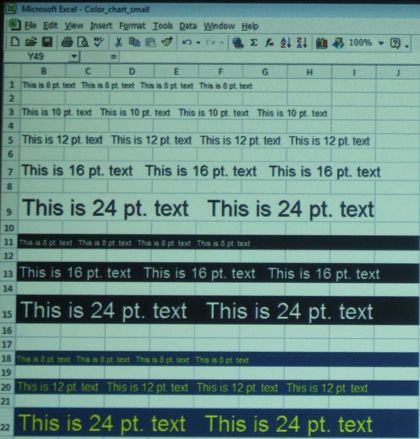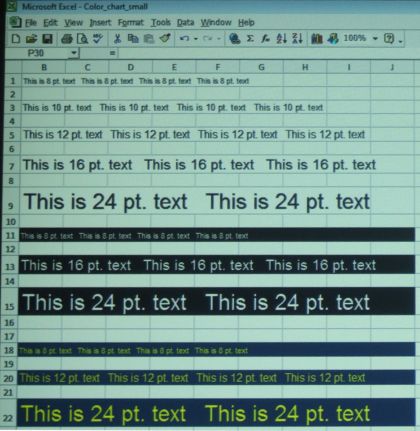Switching to the HDMI input resulted in a slight increase in color depth, but mainly only noticeable in video presentations. As noted in the “Performance” section of this review, using the HDMI input did not measurably increase brightness. Using the USB PC input, there was literally no difference from VGA input in any mode. The good color balance provided in the Normal picture mode ensured that photo presentations displayed good realism and skin tones while maintaining a very bright picture. As mentioned in the Setup and Menu section of this review, the plethora of picture adjustments make it possible to dial in the picture quality, thus eliminating the greenish cast seen in white areas of the brightest modes. Blacks and shadow detail can also be adjusted to provide the most natural look no matter what kind of lighting conditions you encounter in your presentation venue. So, even in less than perfect ambient light settings, the gamma controls will allow you to keep blacks from looking too gray. We also checked the CP-X5021N’s ability to go PC-free and present photos from a USB thumb drive. Photo presentations can be viewed individually or set up as a slideshow, in both cases easily controlled by the remote. Once again, colors were as accurate and deep as when connected to a PC. This is a very convenient feature and enhances the flexibility of the CP-X5021N.
The short version is this: The Hitachi appears sharp. Any sized type, even at higher than native resolutions, will be very readable, IF, the viewer is sitting close enough to see the type well. Distance will be the enemy, not any softness on the part of this Hitachi projector. That is to say, you can't see 10 point type without binoculars on a 120 inch screen from, say 30 feet away. That's why presenters and teachers use print sizes like 60, 48, 36, 30, and 24 points in Powerpoint presentations. Even with perfect text reproduction, you have to sit in the first row to have a chance at 10 point type...
With higher resolutions, the CP-X5021N was still readable with smaller text, though we saw more color fringing, especially at the 8 pt. and 12 pt. sizes. We tried both 1600 x 1200 and 1280 x 800 resolutions, to test the CP-X5021N’s ability to scale and resize these higher resolutions and different aspect ratios. At either resolution, text sizes of 12 pt. and up were still quite readable, though sporting some noticeable pixel offset with the 1280 X 800 resolution. We always like to note that in most presentations, it is unlikely that there would be much (if any) text as small as 12 pts. As compression and scaling technology has improved in recent years, comparing the readability of the smaller text sizes is the only way to point out the differences with non-standard resolutions and aspect ratios. As we’ve noted with other 3-chip projectors, fringing or pixel offset with smaller text is often due more to slight misconvergence than it is to scaling or compression errors.
For nearly all intended uses of the CP-X5021N, it will provide an easily readable display of any supported resolution.
Hitachi CP-X5021N: Video Performance
Our first test of video playback was via a DVD-quality video file played on a laptop computer, connected via VGA. While the CP-X5021N’s 2000:1 contrast ratio would be considered low among home theater projectors, it is a very good ratio for a multimedia projector, especially one this bright. Using Cinema mode as a starting point, we found that skin tones were quite natural and, as we also noted with photo presentations, the overall color balance was quite good. Unfortunately, the default gamma setting for Cinema resulted in mediocre black levels and shadow detail. Trying the other five available gamma setting either did not improve the picture or resulted in crushed blacks that obliterated shadow detail. On the plus side, using a Custom gamma with the Cinema mode would allow you to achieve deeper blacks in a dark room. Also, switching the lamp to Eco mode helped greatly when using Cinema mode in a dark room. Below are examples of the different modes of the Hitachi CP-X5021N projector. The first is Cinema mode, the second is Daytime mode, the third is Dynamic mode, and the last is Normal mode. Connecting the CP-X5021N to a Blu-ray player (downscaled to 720P) via HDMI, the projector retained its good video performance and excellent color balance, all at a brightness level that’s more than twice what many other projectors would provide with this picture quality. As it’s likely that your video presentation will also include sound and the CP-X5021N is billed as a “collegiate series” projector, it’s ability to provide an adequate sound level through its built-in speakers may be important when presenting in a large classroom. Fortunately, the 16-watt output is more than sufficient to create an acceptable volume level without the need for external powered speakers for all but the larger lecture halls.



